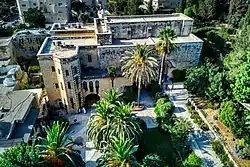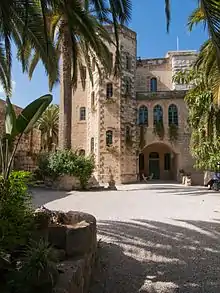

The Benedictine monastery in Abu Ghosh, officially St Mary of the Resurrection Abbey,[1] French: Abbaye Sainte-Marie de la Résurrection d'Abu Gosh) is a monastery run by the Olivetan Benedictine order in Abu Ghosh, Israel.
Its church is built on the foundations of the Crusader-period Church of the Resurrection, or Church of our Lord's Resurrection.[2] It was established in the 12th century on top of Roman ruins in the center of Abu Ghosh, known by the Crusaders as Fontenoid. Until the 19th century, the Arabs called the village Qaryet al-'Inab. The site was associated by the Crusaders with Emmaus from the Gospel of Luke.
France claims ownership of the land as a French Domaine national français en Terre sainte, under the Ottoman capitulations and says this was formalised by the Fischer-Chauvel Agreement of 1948, which has not been ratified by Israel.
History

The late Romanesque/early Gothic-style church[3] was built by the Hospitallers in 1140.[4] It was acquired by the French government in 1899 and placed under the guardianship of the French Benedictine Fathers. Edward Robinson (1838) described it as "obviously from the time of the crusades, and [...] more perfectly preserved than any other ancient church in Palestine." Excavations carried out in 1944 confirm that the Crusaders identified the site as the biblical Emmaus. The church is built over an ancient spring.
From 1956, the monastery was run by the Lazarist Fathers.
Today a double monastery of nuns and priests worship in the church and offer hospitality, commemorating the New Testament story of the couple on the Jerusalem–Emmaus road.[4]
The walls are bearing traces of the Crusader-period frescoes, painted in Byzantine style and restored between 1995 and 2001.[5]
See also
- Crusader churches in Palestine (related aspects)
- Church of St Anne, Jerusalem, almost perfectly preserved building
- Tomb of Mary, once part of the Abbey of Saint Mary of Jehosaphat, where remarcable Crusader frescoes were found
- Church of the Nativity with Byzantine mosaics from the Crusader period
References
- ↑ http://catholicchurch-holyland.com/?p=397
- ↑ Denys Pringle, The Churches of the Crusader Kingdom of Jerusalem: A Corpus, p. 7ff
- ↑ "A Crusader era church, great Middle Eastern food, and the battle for the road to Jerusalem | Sightseeing in Israel".
- 1 2 Martha Ann Kirk, Women of Bible lands: a pilgrimage to compassion and wisdom, p. 143.
- ↑ Colorful Crusader Churches: Visiting the Monastery of the Resurrection. By Jonathan Klawans, 2 August 2023, for Bible History Daily, BiblicalArchaeology Society. Accessed 7 August 2023.
External links
- Official website (in French and English)
- Video of the History and presentation of the benedictine community in Abu Gosh (in French) with subtitles in English.